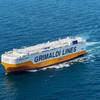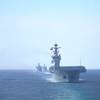LCS MCM MP Puts Navy Closer to Fleet Implementation
NSWC Panama City hosted a two-week demonstration in July that verified Sailors' ability to conduct maintenance on the Littoral Combat Ship's Mine Countermeasure Mission Package without the assistance of civilian scientists or engineers.
The Littoral Combat Ship Mine Countermeasure Mission Package (LCS MCM MP) Sustainment Demonstration (S-Demo) puts the Navy a step closer to transitioning mine countermeasure mission modules to the fleet, offering Joint Force Commanders mine detection and neutralization capability that does not put ships at risk in minefields.
The LCS MCM mission package conducts its mine countermeasures operations through the employment of aviation assets and unmanned surface, semi-submersible, and submersible vehicles, equipped with an array of sensors and systems to detect, localize, neutralize, and sweep mines. These systems are designed to be employed while the LCS remains outside the mine threat area. Future mission package increments add capability, including beach zone mine detection, mine sweeping, near surface mine neutralization, and buried and surf zone mine detection.
"The purpose of the S-Demo is to identify gaps in training, processes, and procedures to make sure gaps are minimized for future operations and support," said Michelle Parker, NSWC PCD S-Demonstration Test Team.
During the demonstration, Sailors assigned to operate and maintain the MCM package, the Littoral Combat Ship Squadron (LCSRON) Mission Package detachment, followed systems and processes in place to perform maintenance tasks on the deployable LCS mine countermeasures equipment, while civilian scientists and engineers collected data. The data gathered will help to improve maintenance processes Sailors will use while on deployment.
"It's our way of ensuring the requisite amount of technical rigor is in place to ensure program success, because at the end of the day we must provide a safe and effective solution to the Fleet," said Ed Stewart, NSWC Panama City Technical Director.
By better estimating the actual time required to perform corrective and preventative maintenance, the sailors have more accurate data when calculating the time necessary to clear a minefield or complete a specific tactic at sea.
"At some point during development, a system will go through what is called a Maintainability Demonstration (M-Demo)," said Peter Halvorson, Lead for Integrated Logistics Support at NSWC Panama City. "It is an event where failures are intentionally introduced into the system to see if trained Sailors can use the written repair procedures (technical manuals) to fix it. This proves out the quality of both training and technical documentation. We're taking this a step further for the LCS MCM MP. We are starting our event with the process leading up to the repair - who gets called, what forms/documentation are filed electronically to alert someone that there is a failure, etc."
Halvorson said a "reach back" process was added to the event, so that if trained Sailors are unable to fix the problem with the technical procedures provided, they are trained to "reach back" into the support infrastructure, typically the Mission Package Support Facility or an In-Service Engineering Agent, and ask for an extra level of expertise to help troubleshoot and fix the failed component.
-NAVSEA-











